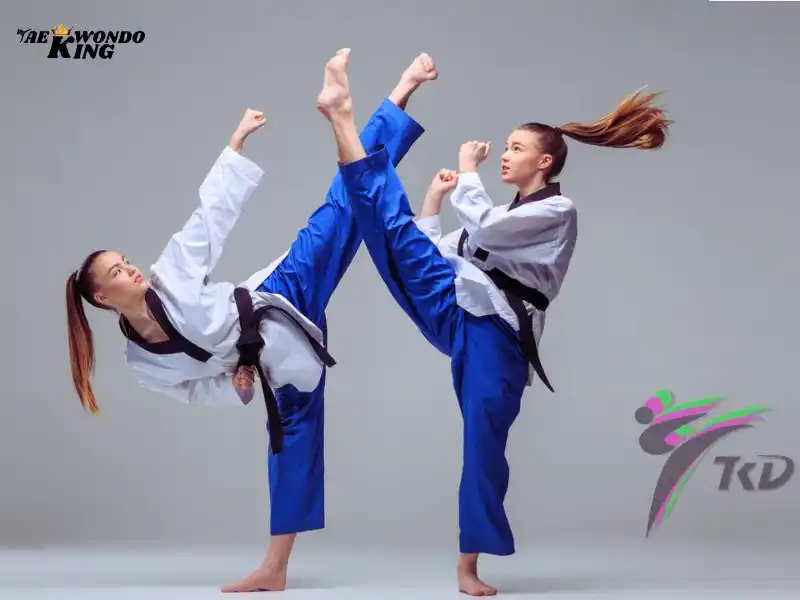
I still remember the first time I tried to pronounce some Taekwondo kicks names—it felt like learning a whole new language with my feet! Back then, I had no idea what a dollyo chagi or yop chagi meant, let alone how to do them right. After years of training and coaching, I’ve come to appreciate how each kick’s name tells a story about its direction, style, and spirit.
Get updates by joining Taekwondoking’s official WhatsApp channel.
In this guide, I’ll walk you through these names in a fun and easy way. Let’s decode the kicks together—you’ll feel more confident at your next class or tournament!
Check out the latest prize in Taekwondo equipment on Amazon.

The Elegance of Taekwondo Kicks
Taekwondo kicks are a testament to the art’s emphasis on flexibility, precision, and explosive power. These kicks are not merely techniques; they are a blend of athleticism and artistry that showcase the practitioner’s mastery over their body. Each kick is executed with grace and intent, making them both effective in combat and captivating to witness.
Taekwondo Martial arts, translated as “the way of the foot and fist,” places a strong emphasis on powerful and precise kicks. The art’s kicks are renowned for their speed, flexibility, and fluidity, making them a hallmark of Taekwondo’s identity. Practitioners devote significant time to mastering these kicks. Which serve both offensive and defensive purposes while showcasing the practitioner’s agility and technique.
All Taekwondo Kicks Names
Taekwondo is a Korean martial art known for its high-flying kicks and dynamic techniques. It has captivated practitioners and spectators alike with its impressive array of spices. These kicks, each possessing a distinct name and purpose, are integral to the art’s identity and effectiveness. I delve into the world of Taekwondo kick techniques, exploring their names, execution, and significance within the discipline.
Embark on a journey through Taekwondo’s essence with our guide to Taekwondo kicks’ names. From Front Kicks to Roundhouse Kicks, explore the intricate techniques that define this dynamic martial art. Each kick holds a unique purpose and power, showcasing the fusion of precision and athleticism.
Korean Names for Various Taekwondo Kicks Axe Kick–Naeryeo Chagi Back Kick–Dwi Chagi (“D-we Cha-gee”) Crescent Kick–Bandal Chagi Flying Back Kick–Twi-myo Dwi Chagi Flying Side Kick–Twi-myo Yeop Chagi Front Kick–Ap Chagi (“Ap Cha-gee”) Hook Kick–Huryeo Chagi Jumping Front Kick – Eedan Ap Chagi Kick–Chagi (“Cha-gee”)–Generic term for kick Knee Strike–Moreup Chagi, Kawi Chagi Side Kick -Yeop Chagi–This term uses the word chagi (which means strike) and not chagi (which means kick).

The Array of Taekwondo Kicks Names
Taekwondo, a martial art renowned for its dynamic and high-flying techniques, has captivated practitioners and enthusiasts worldwide. Central to the art’s distinctive identity are its powerful kicks, each bearing its unique name and purpose. I dive into the exciting world of Taekwondo kicks, names with pictures, execution, and significance in the art of Taekwondo.
Dive into our concise overview of Taekwondo kick names with pictures, enhancing your understanding of this captivating discipline. Elevate your martial arts knowledge today!
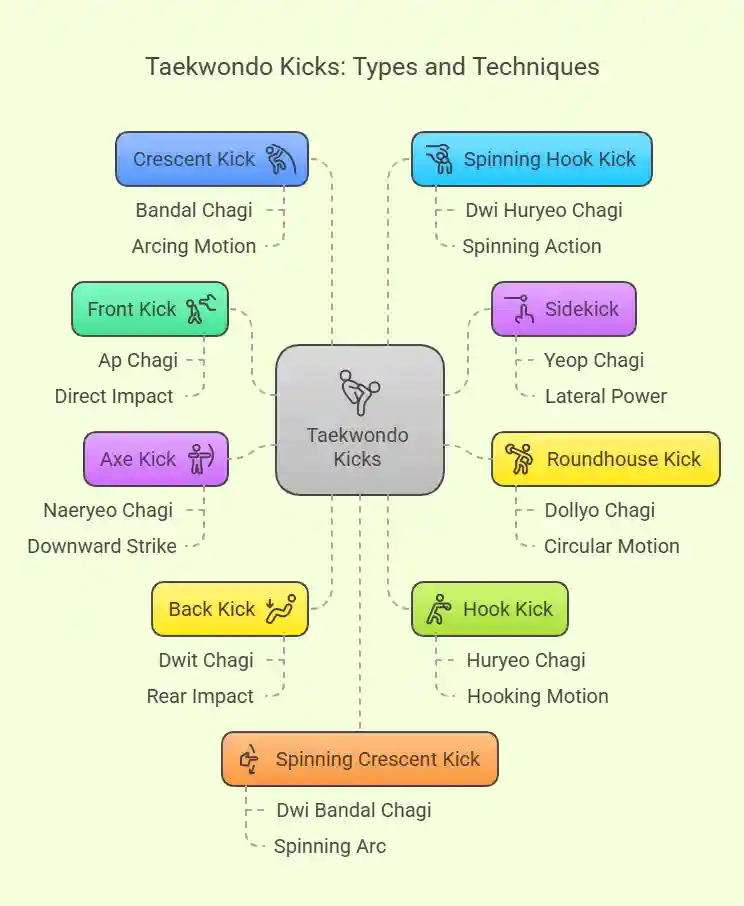
Front Kick (Ap Chagi):
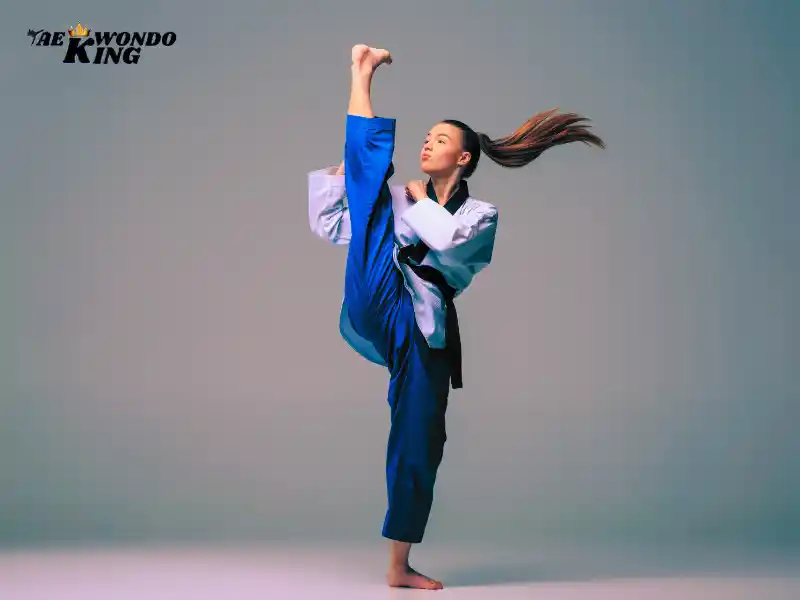
The Front Kick, or “Ap Chagi,” is one of the fundamental kicks in Taekwondo. It involves lifting the knee toward the target and extending the foot forward to strike with the ball of the foot. This kick is versatile and can be used to target various areas, including the abdomen and chest. The front kick is one of the fundamental kicks in Taekwondo. Executed by lifting the knee and extending the leg forward, the kick is aimed at the opponent’s midsection or head. The front kick is a versatile technique used for both offense and defense, allowing practitioners to maintain distance from their opponent while delivering a powerful strike.
Sidekick (Yeop Chagi):
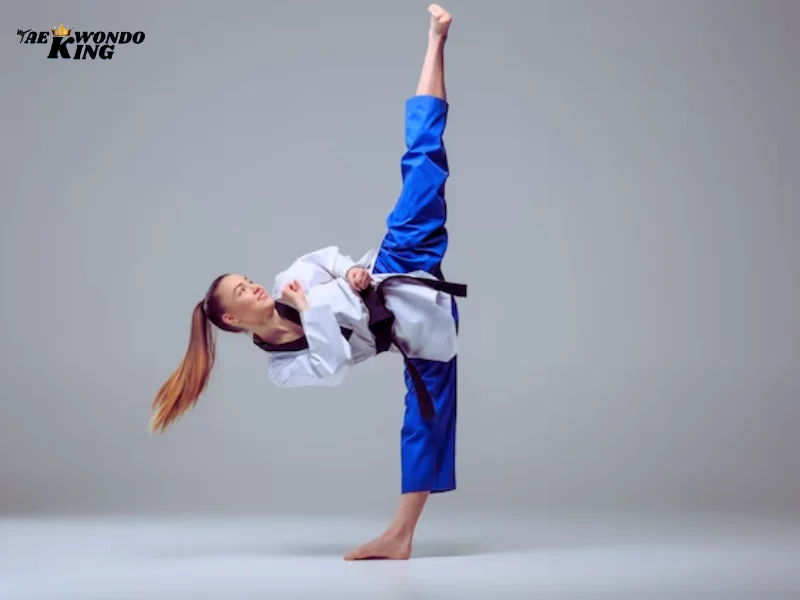
The sidekick, or “Yeop Chagi,” is characterized by its lateral movement. It involves lifting the knee to the side and then extending the leg outward, striking with the edge of the foot. The sidekick is known for its effectiveness in pushing opponents away and creating distance. The sidekick involves thrusting the leg sideways with the striking surface of the foot. It’s a linear kick that targets the opponent’s ribs or head. The sidekick’s effectiveness lies in its ability to generate substantial power and cover distance quickly, making it an ideal choice for counterattacks and breaking an opponent’s guard.
Roundhouse Kick (Dollyo Chagi):
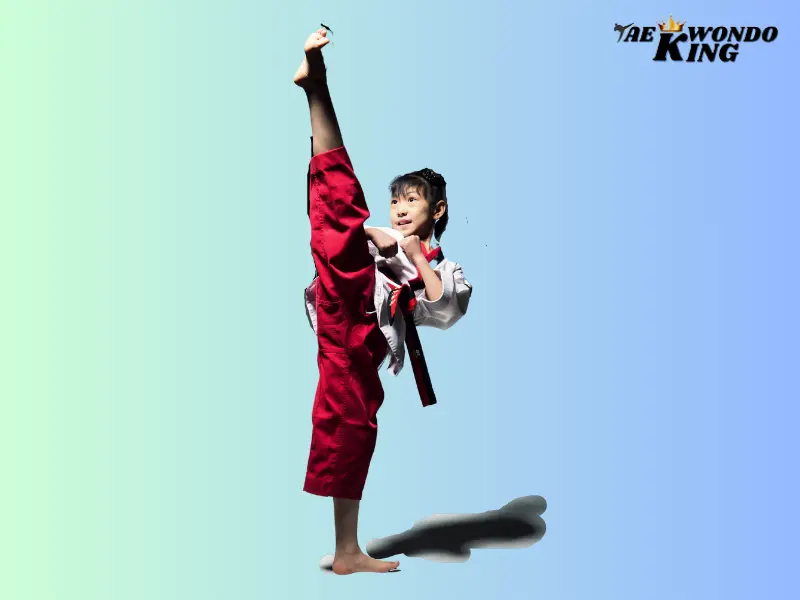
The Roundhouse Kick, or “Dollyo Chagi,” is a staple in Taekwondo’s repertoire. This kick involves pivoting on the support leg while lifting the knee and extending the foot in a circular motion, striking with the instep or ball of the foot. The Roundhouse Kick is favored for its speed and versatility in targeting various areas. The Dollyo Chagi kick is a circular kick that involves rotating the hips and extending the leg to strike the opponent with the instep or ball of the foot. This kick is delivered horizontally, allowing it to hit the opponent’s body, head, or legs from various angles.
Axe Kick (Naeryeo Chagi):
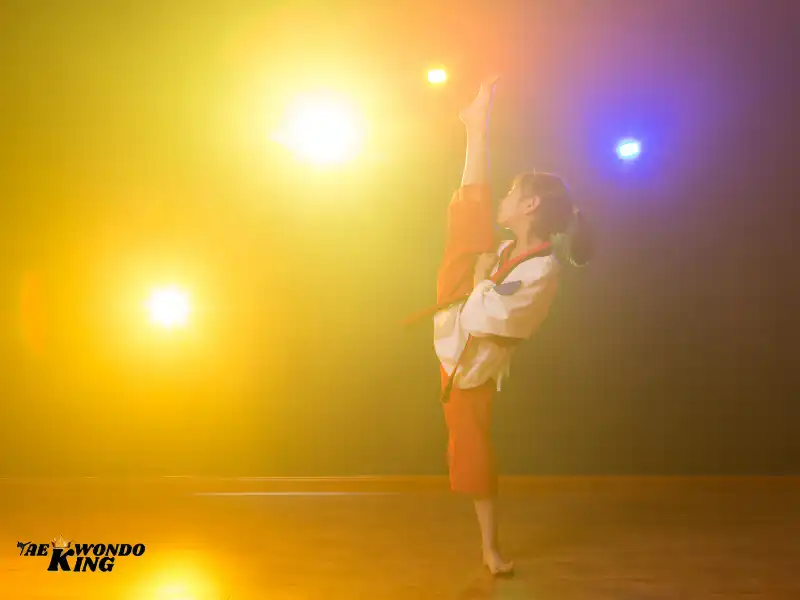
The Axe Kick, or “Naeryeo Chagi,” is a visually impressive technique. It involves raising the knee and then snapping the leg downward, striking with the heel or outer edge of the foot. This kick is often used against taller opponents and effectively targets the head and shoulders. The axe kick is a descending kick where the leg is raised high and then brought down rapidly in a chopping motion. The striking surface is the heel or blade of the foot, making it effective for targeting the crown of the opponent’s head or shoulders. The axe kick’s trajectory and surprise factor often catch opponents off guard.
Check out the latest prize in Taekwondo equipment on Amazon.

Back Kick (Dwit Chagi):
The Back Kick, or “Dwit Chagi,” is executed by turning the body away from the target and striking with the heel of the foot. This kick relies on speed and surprise to catch opponents off guard. The Back Kick is commonly used in defensive scenarios. The back-kick involves striking the opponent with the heel of the foot while facing away from them. It’s a powerful technique that relies on quick hip rotation and precision.
Hook Kick (Huryeo Chagi):
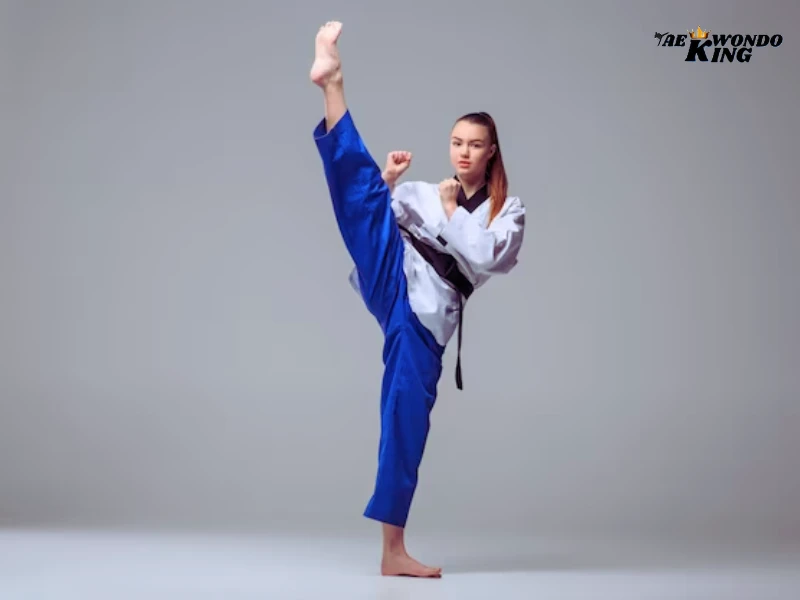
The Hook Kick, or “Huryeo Chagi,” involves bending the knee while extending the leg outward in a semi-circular motion, striking with the heel or instep. This kick effectively targets opponents at an angle and is often used as a counter technique. The hook kick is characterized by a sweeping arc motion, involving bending the knee and then extending the leg to strike the opponent’s head or torso with the heel or ball of the foot. The hook kick’s curved trajectory can be deceptive and challenging for opponents to anticipate, making it an effective tool for creating openings.
Crescent Kick (Bandal Chagi):
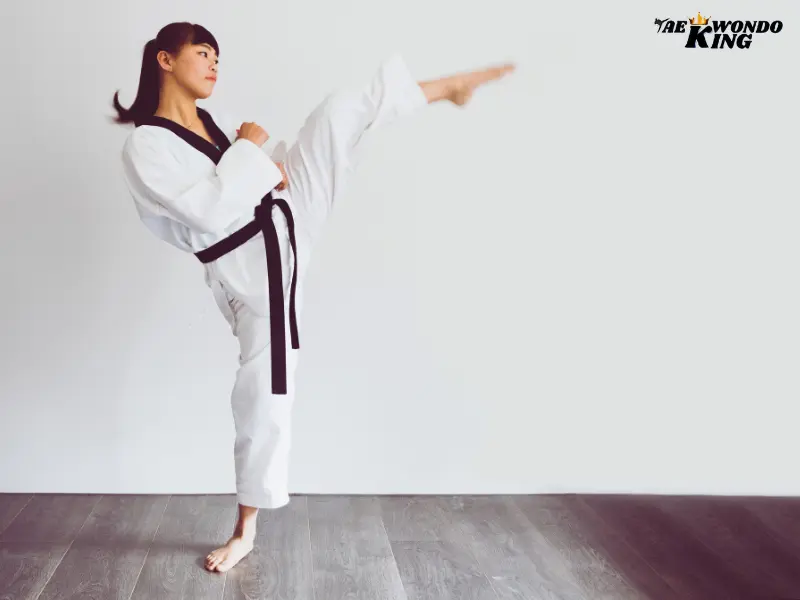
The Crescent Kick, or “Bandal Chagi,” is characterized by its curved trajectory. It involves lifting the knee and extending the leg in an arc, striking with the edge of the foot. The Crescent Kick is versatile and can be used for both offensive and defensive purposes. The crescent kick follows a circular trajectory, with the leg swinging horizontally and striking the opponent using the blade of the foot. This kick is particularly effective for targeting the head or neck. Its wide arcing motion allows practitioners to generate power while keeping their opponents at bay.
Spinning Hook Kick (Dwi Huryeo Chagi):
The Spinning Hook Kick, or “Dwi Huryeo Chagi,” is a dynamic technique that requires a 360-degree spin before executing a Hook Kick. This kick combines speed, power, and surprise, making it a formidable weapon in a practitioner’s arsenal. The spinning hook kick combines the spinning motion of a roundhouse kick with the sweeping motion of a hook kick. The practitioner rotates their body and executes the kick with a rapid spinning movement. This kick’s speed and unexpected angle make it a potent weapon for surprising opponents and delivering powerful strikes.
Spinning Crescent Kick (Dwi Bandal Chagi):
Similar to the Spinning Hook Kick, the Spinning Crescent Kick, or “Dwi Bandal Chagi,” involves a 360-degree spin. It also provides the Korean names for these Taekwondo kicks. However, instead of a hooking motion, the leg follows a crescent trajectory, striking with the edge of the foot.
Jumping Front Kick (Twimyo Ap Chagi):
The Jumping Front Kick, or “Twimyo Ap Chagi,” adds an aerial element to the Front Kick. It involves jumping off the support leg while executing a Front Kick in mid-air. This kick combines height, power, and surprise to overwhelm opponents. Jumping Back Kick/ Eedan Dwi Chagi- Aware schools use Korean words for jumping, flying interchangeably, so an instructor might use Eedan for a flying kick.
Mastering the Art of Taekwondo Kicks

The art of Taekwondo kicks goes beyond mere physical technique. It requires a deep understanding of body mechanics, timing, and strategy. To master these kicks, practitioners must invest time in refining their flexibility, balance, and precision. To master Taekwondo kicks, practitioners must invest time and effort into honing their technique, flexibility, and timing. Under the guidance of skilled instructors, regular training allows practitioners to develop proper form, power, and accuracy in executing these kicks. Mental focus is crucial, as mastering kicks involves understanding their applications in various scenarios. Practitioners must learn to adapt their kicks to different distances, angles, and opponents, ensuring that their movements remain fluid and effective.
Flexibility is a cornerstone of Taekwondo kicks. Regular stretching routines help practitioners achieve the range of motion required for high, accurate kicks. Dynamic stretches, static stretches, and partner-assisted stretches contribute to increased flexibility over time. Maintaining balance during kicks is essential for accuracy and control. Practitioners work on their core strength and stability to execute kicks with minimal loss of balance. Balance training, such as one-legged stances and kicking drills, enhances a practitioner’s ability to stay grounded.
Poomsae (forms) practice and target-specific drills contribute to honing precision. Timing is crucial to successful kick execution. Practitioners learn when to initiate a kick, whether a counter in response to an opponent’s movement or an offensive strike that catches them off guard. Sparring and partner drills help refine timing skills. Speed and power are the hallmarks of effective Taekwondo kicks. Practitioners engage in plyometric exercises, strength training, and kicking drills to enhance the explosiveness of their kicks. Developing speed and power ensures that kicks are not only accurate but also impactful.
The Journey of a Taekwondo Kicker
Embarking on the journey of mastering Taekwondo kicks is a rewarding endeavor that encompasses physical development, mental discipline, and personal growth. As practitioners progress, they not only refine their techniques but also embody the principles of Taekwondo, such as courtesy, integrity, perseverance, self-control, and indomitable spirit.
Taekwondo kicks symbolize the harmonious integration of mind, body, and spirit. They embody the philosophy of using controlled force for positive outcomes. The journey of a Taekwondo kicker is not only about acquiring skills but also about nurturing virtues that extend beyond the training mat.
How many kicks are there in Taekwondo?
Taekwondo encompasses a diverse array of kicking techniques. In TKD, the number of kicks is not fixed, as practitioners continuously explore and refine their skills. However, some fundamental kicks form the backbone of Taekwondo.
- Front Kick (Ap Chagi): A basic kick where the foot is thrust straight ahead, targeting the opponent’s midsection.
- Roundhouse Kick (Dollyo Chagi): Executed by swinging the leg in a circular motion, striking with the top of the foot.
- Side Kick (Yeop Chagi): Involves a sharp thrust of the foot to the side, commonly aimed at the opponent’s torso.
- Back Kick (Dwit Chagi): A powerful kick executed by thrusting the foot backward towards the opponent.
- Hook Kick (Huryeo Chagi): This kick involves bending the knee and striking the target in a circular motion.
- Crescent Kick (Bandal Chagi): Circular like the hook kick, but targets the head or neck area in a sweeping motion.
- Axe Kick (Naeryeo Chagi): Involves a downward motion of the foot, often striking the opponent’s head or collarbone.
- Spinning Hook Kick (Dwi Huryeo Chagi): An advanced technique where the practitioner rotates before executing a hook kick.
- Whip Kick (Dwijibo Chagi): A rapid, snapping kick resembling the motion of a whip.
- Flying Kick (Twimyo Chagi): These are dynamic kicks executed while airborne, showcasing the practitioner’s agility.
The beauty of Taekwondo lies in its adaptability. Practitioners can modify these kicks, combining them or adding personal flair. Moreover, each kick serves a specific purpose – be it offensive, defensive, or a strategic move to create distance.
Kicking techniques set it apart, promoting flexibility, balance, and precision. A beginner or an advanced practitioner, the journey in Taekwondo involves mastering these kicks, understanding their applications, and continuously refining the artistry of each movement.
Check out the latest prize in Taekwondo equipment on Amazon.

Top 10 Taekwondo Kicks Names
Taekwondo, renowned for its high-flying and powerful kicks, boasts a diverse array of kicking techniques. Here are the top 10 Taekwondo kicks that showcase the art’s dynamic and athletic nature:
- Front Kick (Ap Chagi): A fundamental kick aimed straight ahead, targeting the opponent’s midsection with the ball of the foot.
- Roundhouse Kick (Dollyo Chagi): Executed by swinging the leg in a circular motion, striking with the top of the foot or instep.
- Side Kick (Yeop Chagi): Involves thrusting the foot to the side, targeting the opponent’s torso or face.
- Back Kick (Dwit Chagi): A powerful kick delivered by thrusting the foot backward towards the opponent.
- Hook Kick (Huryeo Chagi): In this kick, the leg is bent at the knee, and the foot strikes the target in a hooking motion.
- Crescent Kick (Bandal Chagi): This circular kick is often aimed at the head or neck area, executed in a sweeping motion.
- Axe Kick (Naeryeo Chagi): Features a downward motion of the foot, targeting the opponent’s head or collarbone.
- Spinning Hook Kick (Dwi Huryeo Chagi): An advanced spinning kick where the practitioner rotates before delivering a hook kick.
- Whip Kick (Dwijibo Chagi): This kick involves a rapid and snapping motion, resembling the action of a whip.
- Flying Kick (Twimyo Chagi): Demonstrating the art’s aerial prowess, these are dynamic kicks executed while airborne.
Name of the 6 Basic kicks in Taekwondo
Taekwondo, a Korean martial art renowned for its emphasis on kicking techniques, encompasses a set of fundamental kicks that form the cornerstone of a practitioner’s skill set. Here are the names of six basic kicks in Taekwondo:
- Front Kick (Ap Chagi): This is the most straightforward kick, involving a forward thrust of the foot. It is often aimed at an opponent’s midsection.
- Roundhouse Kick (Dollyo Chagi): Executed by pivoting on the ball of the support foot, this kick involves a circular motion, striking the opponent with the top of the foot.
- Side Kick (Yeop Chagi): As the name suggests, this kick is directed sideways, targeting the opponent’s torso or face. It requires a lateral thrust of the leg.
- Back Kick (Dwit Chagi): In this kick, the practitioner turns their back to the target and executes a powerful thrust backward with the heel.
- Hook Kick (Huryeo Chagi): Characterized by a hooking motion, this kick involves bending the knee and striking the target with the instep or ball of the foot.
- Crescent Kick (Bandal Chagi): This kick follows a sweeping, crescent-shaped trajectory. It is often employed to target an opponent’s head or neck.
These basic kicks serve as the building blocks for more complex and advanced techniques in Taekwondo. Mastery of these foundational kicks not only develops a practitioner’s agility and flexibility but also lays the groundwork for the dynamic and acrobatic kicks that are characteristic of Taekwondo as an art form.
What are the kicks in Taekwondo and their names?

Taekwondo, renowned for its dynamic and powerful kicks, features an array of signature techniques with distinct names. The fundamental front kick is known as “Ap Chagi,” executed with the ball of the foot. The “Dollyo Chagi” is a roundhouse kick, striking with the top of the foot or the instep. For a powerful sidekick, practitioners employ the “Yop Chagi,” targeting the opponent’s torso. The jumping front kick is called “Twimyo Ap Chagi,” adding aerial agility to the strike. Lastly, the spinning hook kick, or “Dwijibo Huryeo Chagi,” involves a swift rotation before the striking motion. These kicks showcase the versatility and precision that define Taekwondo’s kicking repertoire.
What are the kicks in Taekwondo called in Korean?
In Taekwondo, the kicks are not only dynamic in execution but also bear distinct names in Korean, reflecting the rich tradition of this martial art. The fundamental front kick is referred to as “Ap Chagi,” emphasizing precision and speed. The roundhouse kick, a cornerstone of Taekwondo, is known as “Dollyo Chagi,” showcasing the circular motion of the strike. For lateral attacks, practitioners employ the “Yop Chagi,” executing a potent sidekick.
The jumping front kick is termed “Twimyo Ap Chagi,” combining aerial prowess with the straightforward front kick. Lastly, the spinning hook kick, a display of agility, is named “Dwijibo Huryeo Chagi” in Korean, highlighting the rotational aspect of this powerful kick. These Korean names add cultural depth to Taekwondo’s kicking techniques.
How to do kicks in Taekwondo?
Mastering kicks in Taekwondo requires disciplined practice and a focus on fundamental techniques. Begin with the foundational front kick, “Ap Chagi,” by raising the knee and extending the foot swiftly. For the roundhouse kick, or “Dollyo Chagi,” pivot on the supporting foot and unleash a circular kick with the top of the foot or instep. Execute the sidekick, “Yop Chagi,” by lifting the knee and thrusting the foot sideways towards the target.
To add aerial flair, practice the jumping front kick, “Twimyo Ap Chagi,” coordinating a jump with the front kick motion. Advanced practitioners can incorporate the spinning hook kick, “Dwijibo Huryeo Chagi,” involving a rapid spin before executing the powerful kick. Consistent and mindful training is key to refining these dynamic Taekwondo kicks.
How to do a 540 kick in Taekwondo?
The 540 kick in Taekwondo is an advanced and visually impressive technique that requires agility, strength, and precise execution. Begin by assuming a fighting stance and initiating a spin with the non-kicking leg, turning 360 degrees. As the body rotates, bring the kicking leg around in a sweeping motion, generating momentum. Extend the kicking leg with power and control, aiming for a mid-air spin and a 180-degree landing.
Key elements include maintaining balance, a swift spin, and a dynamic kick motion. Mastery of the 540 kick demands dedicated practice, gradual progression, and a deep understanding of body mechanics, making it a showcase of skill and athleticism in Taekwondo.
Conclusion,
The names and techniques of Taekwondo kicks are a testament to the art’s rich history, philosophy, and effectiveness. Each kick has its purpose, from offense to defense, from precision to power. Embracing the journey of mastering these kicks is an invitation to explore the intricacies of Taekwondo and uncover the potential within oneself. As practitioners continue to train, refine, and execute these dynamic kicks, they step into a world where athleticism and artistry unite in a symphony of movement and discipline.
Check out the latest prize in Taekwondo equipment on Amazon.

FAQ
How to achieve a black belt in Taekwondo?
To achieve a black belt in Taekwondo, you need to follow a structured training program and meet certain requirements set by your Taekwondo school or organization. Here are some general steps to achieve a black belt:
1. Find a reputable Taekwondo school or instructor to train with. Make sure they are affiliated with a recognized Taekwondo organization.
2. Begin your training by attending regular classes and learning the basic techniques, forms (poomsae), and sparring drills.
3. Progress through the various color belts by passing belt promotion tests. Each belt level will have its own set of requirements, including demonstrating proficiency in techniques, forms, and sparring.
4. Train consistently and practice outside of class to improve your skills and knowledge.
5. As you advance through the color belts, you will eventually reach the recommended level to test for your black belt. This may involve a written exam, a physical test of your techniques and forms, and a sparring demonstration.
6. Once you pass the black belt test, you will be awarded your black belt and officially be recognized as a black belt in Taekwondo.
Remember that achieving a black belt requires dedication, perseverance, and a commitment to continuous learning and improvement. The journey to a black belt is a long-term process, so be patient and enjoy the experience.
How to achieve a high kick in Taekwondo?
To achieve a high kick in Taekwondo, you can follow these steps:
1. Warm-up: Begin by warming up properly to loosen your muscles and increase flexibility.
2. Stretching: Concentrate on stretching your legs and hips to improve your range of motion.
3. Technique: Practice the correct technique for high kicks, which involves engaging your core, fully extending your leg, and using your hips to generate power.
4. Flexibility exercises: Include exercises like leg swings, front and side splits, and hamstring stretches to improve your flexibility gradually.
5. Conditioning: Strengthen your leg muscles by performing exercises like squats, lunges, and calf raises to enhance your kicking power.
6. Practice: Regularly practice your high kicks, starting with lower heights and gradually increasing as you improve your flexibility and strength.
Always remember to warm up, stretch, and listen to your body to prevent injuries and steadily improve your high kicks.
How to achieve a spinning hook kick in Taekwondo?
To perform a spinning hook kick in Taekwondo, follow these steps:
1. Begin in a fighting stance with your dominant leg positioned at the back.
2. Rotate your body and hips by pivoting on your front foot.
3. Simultaneously, lift your back leg and bend your knee, shaping your foot into a hook.
4. Extend your leg, aiming to strike your target with the heel or outer edge of your foot.
5. Maintain balance and control throughout the kick.
6. After executing the kick, rotate your body back to the starting position.
Remember to practice the kick gradually, gradually increasing your speed and power while maintaining proper technique. It is highly recommended to learn and practice under the guidance of a qualified Taekwondo instructor.
How to achieve a jumping front kick in Taekwondo?
To achieve a jumping front kick in Taekwondo, follow these steps:
1. Start in a fighting stance with your dominant leg behind you.
2. Begin by bending your knees slightly and quickly exploding upward, using the power from your legs.
3. As you jump, bring your dominant knee up towards your chest.
4. Extend your leg forward in a front kick motion, aiming for your target.
5. Keep your non-kicking leg tucked in for balance and control.
6. Use your core muscles to maintain stability in the air.
7. As you land, make sure to absorb the impact with your legs and maintain your balance.
8. Practice this technique repeatedly to improve your jumping front kick.
How to achieve a powerful sidekick in Taekwondo?
To achieve a powerful sidekick in Taekwondo, it is important to focus on the following:
1. Proper technique: Make sure to have a solid foundation in the correct technique for a sidekick. This includes proper foot positioning, hip rotation, and extension of the leg.
2. Flexibility: Develop good flexibility in the hips, hamstrings, and groin area. Regular stretching exercises, such as dynamic stretches and static holds, can help improve your flexibility.
3. Core strength: Strengthen your core muscles, including the abdominals and lower back, as they play a crucial role in generating power for a sidekick.
4. Practice drills: Regularly practice drills specifically designed to improve the power and speed of your sidekick. This can include kicking against resistance, using a heavy bag, or practicing with a partner holding a pad.
5. Conditioning: Incorporate strength and conditioning exercises into your training routine to build overall strength and power in your legs.
Remember, achieving a powerful sidekick takes time and consistent practice. It is important to train under the guidance of a qualified instructor to ensure correct technique and to prevent any injuries.
How to achieve a high roundhouse kick in Taekwondo?
To achieve a high roundhouse kick in Taekwondo, it is important to focus on flexibility, balance, and technique. Here are some steps to help you improve your roundhouse kick:
1. Warm-up: Always start with a proper warm-up to increase blood flow and loosen up your muscles.
2. Stretching: Perform dynamic stretches to warm up the muscles you will be using during the kick, such as your hamstrings, hip flexors, and groin. Static stretching after your training session can also help improve flexibility.
3. Hip rotation: The power for a roundhouse kick comes from the rotation of your hips. Practice hip rotation exercises to build strength and flexibility in your hip muscles.
4. Chambering: Proper chambering is important to generate power and speed. Practice bringing your knee up towards your chest while keeping your foot relaxed, and then extend your leg with a snapping motion.
5. Balance: Focus on maintaining good balance throughout the kick. Keep your supporting foot planted firmly on the ground and engage your core muscles to help with balance.
6. Height: Gradually work on increasing the height of your kick. Start with lower kicks and gradually extend your leg higher as your flexibility and strength improve.
7. Practice: Consistent practice is key to improving your roundhouse kick. Regularly practice the kick with proper technique and gradually increase the intensity and speed.
Remember to always train under the supervision of a qualified instructor to ensure proper form and technique.
Check out the latest prize in Taekwondo equipment on Amazon.


Founder, Owner, and CEO of TaekwondoKing.
He is one of the top 100 martial artists in the World and among the top 20 referees in Bangladesh.
Ehatasamul Alom is an esteemed Kukkiwon Certified Taekwondo 3rd Dan Black Belt with over 15 years of experience in this dynamic martial art. Born in Rajshahi, Bangladesh, Ehatasamul’s journey with Taekwondo began at the tender age of seven. His passion led him to compete at national and international levels, where he has bagged numerous awards and honors. He is also a member of the Taekwondo National Referee Panel.
With a Bachelor’s degree in Sports Science from the prestigious Rajshahi University, Ehatasamul has a deep understanding of the technical and scientific aspects of martial arts and some other martial arts.
In 2022, Ehatasamul created the “TaekwondoKing.com” blog to share his knowledge and Real experiences. His articles focus on Taekwondo training techniques, competition strategies, and the art’s rich history and philosophy. He also writes about the importance of mental fortitude and discipline, key aspects of his teaching philosophy. His goal is to inspire both beginners and seasoned practitioners worldwide through insightful and engaging content.
If you need any help, contact Ehatasamul Alom at any time.


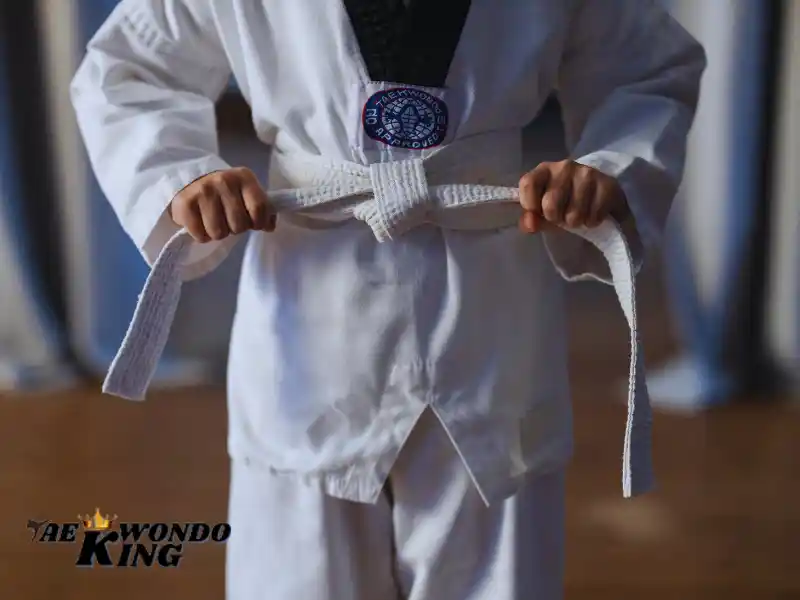


This post will assist internet visitors for setting up a new blog or even a weblog from start to end.
Thanks for sharing. I read many of your blog posts, cool, your blog is very good.
Your point of view caught my eye and was very interesting. This site is amazing! It offers a perfect blend of tips, stories, and expert advice on Taekwondo. Thanks.